If you’re thinking about hitting Iceland’s roads in the depths of winter, you’re either admirably adventurous or slightly unhinged, possibly both (but I like that). The rewards, however, are enormous: frozen waterfalls that look sculpted by Norse gods (try and prove me they weren’t), vast empty landscapes, and the peace you simply can’t find when tour buses are clogging the lay-bys. In this guide, I’ll steer you through everything you need to know to stay safe, warm, and well in control while driving through one of the world’s most dramatic winter wonderlands (snow, ice, sleet, more ice).
Why Winter Driving in Iceland Is a Whole Different Beast
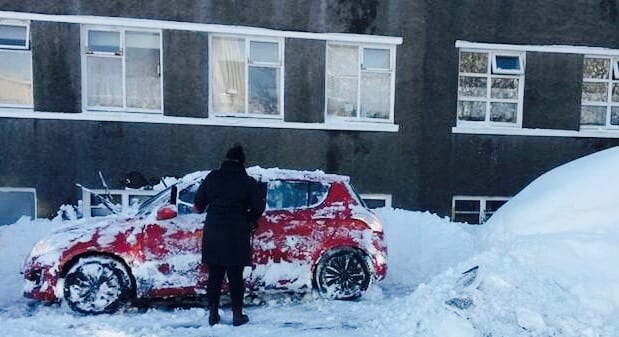
Ah, Iceland in winter. A land described where elves probably own snow shovels, and the weather forecast changes faster than a toddler’s mood (maybe not all). It’s beautiful, of course, but behind that beauty lurks a mischievous beast: winter driving.
This isn’t your typical frosty road trip. The season transforms the landscape and the driving experience completely. Roads that were once smooth in July now turn into slippery ribbons of ice with wispy snow blowing over the roads by December.
The sunlight you took for granted in summer becomes a rare treat, hanging low for just a few precious hours each day (3-4 during peak winter). Then add to that my worst nemesis out here, the wind. An invisible force of nature capable of slamming car doors shut and nudging entire vehicles across the road, or worse, at its peak strength, and you begin to see why Icelanders treat winter with a mix of caution and admiration (except anyone who drives a Ram vehicle generally seems ambivalent to it).
Driving through Iceland in these months means mastering a new rhythm. You plan your days around weather alerts, road closures, and often to maximise your chances of seeing the famous aurora borealis. It’s all about embracing the journey at the pace nature allows (and don’t fight it). For those willing to adapt, it’s an experience like no other: the roads are quieter, and the country feels like it belongs entirely to you (especially when you barely pass by other vehicles for extended periods of time).
Locals have a love-hate relationship with the season. They’ll tell you, usually with a grin, that the wind can make a drive through experience your only option, yet they still pile into their 4x4s for a drive. Why? Because there’s something quite oddly fun about winter travel here, from the solitude to the snow-covered landscapes, and regular sightings of the Northern Lights flickering above your windscreen on evening trips into the countryside.
Beneath all that hardship lies a sort of quiet reward: the serenity that comes when you realise you’re completely at the mercy of the elements, and perfectly fine with it.
So yes, it’s different. But that’s precisely why it’s brilliant (you should be hearing keys jangling in your mind by this point in the guide).
Can You Actually Drive in Iceland During Winter?

In short, yes, you absolutely can.
But there’s a difference between can and should, and that distinction can make or break your road trip. Iceland’s main roads, including the famous Ring Road (basically the only main road, you can’t miss it), are ploughed and patrolled year-round, connecting towns, petrol stations, and all of the major postcard natural landmarks.
The country does a pretty impressive job of keeping these arteries open despite conditions that would send most of Europe into a collective panic. That said, you’ll need to drive differently in different conditions. For instance, stay slow, cautious, and with your eyes peeled for warning signs that can change your route in an instant (if you’ve ever wanted to develop some kind of weather-kinesis ability, now is the time).
The adventurous among you may be tempted by those mysterious F-roads you spotted on Google Maps, the ones that snake enticingly into Iceland’s interior. Resist that urge. These mountain routes are strictly closed from around September until June due to deep snow, landslides, and rivers that freeze and thaw unpredictably (not fun). The authorities even issue heavy fines for entering the Icelandic highlands during the closed season, so best to leave those for a summer return trip.
Legally, driving in Iceland during winter is very straightforward. You can start your journey behind the wheel with a valid licence from most countries, as long as you drive on the right-hand side (really only a struggle for Brits like me at first). But legality and practicality are not always the same thing. Before you set out, check the Icelandic Road Administration website for live updates on closures and conditions (our team will fill you in at the office as well).
Insurance-wise, don’t skip the fine print. Many rental companies exclude weather-related damage, such as sandblasting from volcanic ash, or undercarriage damage from unseen ice ridges. That’s why our team takes this reality seriously, so our winter-ready vans come equipped with robust insurance, studded tyres, and emergency gear designed specifically for Icelandic conditions. You might never need it, but you’ll be grateful it’s there if you do.
You should also prepare mentally for a slower pace. Average winter speeds can dip well below posted limits, not because you’re timid, but because the conditions demand it. Locals know this and plan their days accordingly, allowing time for storms to pass or roads to be cleared (when in doubt, get behind one of the Snowplows).
The golden rule here is respect for the weather, the roads, and your own limits. If Iceland’s elements send you a message (such as, “No driving today”) consider it divine wisdom, not a suggestion (and let me know if the weather uses WhatsApp or just normal SMS).
The Best (and Worst) Roads to Drive in Winter
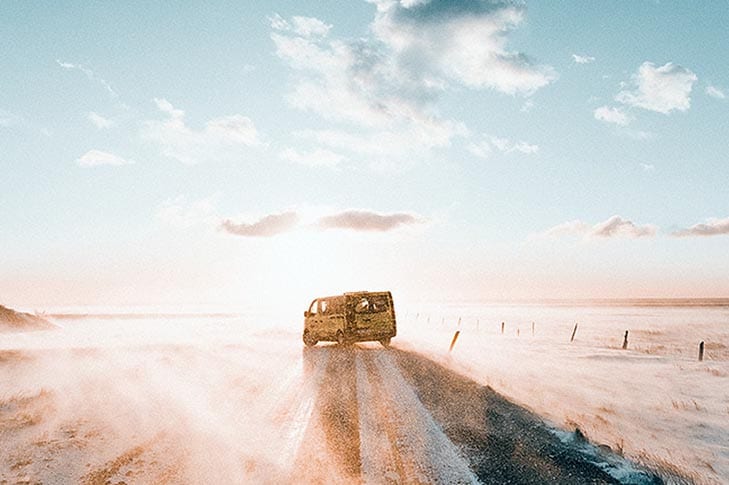
Let’s talk roads in Iceland, or, more specifically, the ones that can get a little hairier in the wintertime.
The Ring Road (Route 1) is your trusty friend in winter, the backbone of Iceland’s road network. It loops around the island like a woolly scarf, connecting Reykjavik to Akureyri, Egilsstaðir, Höfn, and beyond. The road is ploughed regularly, marked clearly with reflective poles, and monitored by the Icelandic Road Administration for closures and hazards in real-time (it’s pretty rare when parts of it close, though it does happen when storms turn up).
In good weather, it’s a joy to drive, wide enough for campervans, lorries and trucks alike, with long stretches of open views where the landscape looks more like a film set than reality. But even Route 1 has its quirks: strong crosswinds near exposed coastal areas, black ice in hidden pockets, and sudden snow squalls that can sometimes even deliver whiteouts. Driving it in winter is less about speed and more about rhythm. You need to simply anticipate conditions, watch for warning lights, and know when to pull over for a breather (or a coffee and a calm down).
What you’ll want to avoid are the interior Highland routes: roads like F35 (Kjölur), F26 (Sprengisandur), or F208 (Fjallabaksleið). These rugged trails are legendary among summer travellers but become impassable once snow arrives. Closed by law from roughly September to June, they’re often buried under metres (or, feet for those from the US) of snow and riddled with frozen river crossings. Attempting them in winter is illegal, and rescue operations here can take a very long time. Even some secondary gravel roads near popular spots, like those leading into the Þórsmörk valley or Landmannalaugar, become inaccessible until spring.
The Westfjords, stunning as they are, pose their own logistical headache. This northwestern arm of Iceland juts into the proper Arctic and receives some of the heaviest snowfall in the country (the old Polaroid pictures are pretty nuts). Most of the roads twist through mountain passes that freeze solid and are frequently closed for avalanche prevention. Many locals themselves don’t bother attempting long-distance drives there between November and March (they are probably awesome as Sudoku by now). Unless you’ve decided to join the rescue operations, I’d suggest leaving this region alone until summer (despite the lower number of tourists).
By contrast, the south and west of Iceland are ideal for winter driving. Routes between Reykjavik and Vík offer dramatic coastlines, waterfalls, glaciers, and very manageable road conditions (only one small mountain pass at hellisheiði). This will also allow you to find the kind of Iceland you see in postcards: Seljalandsfoss, Skógafoss, and, of course, Reynisfjara black sand beach with crashing waves (don’t go too near the water’s edge, please). These areas benefit from higher traffic and more frequent snow clearance, which means if a storm so happens to shut you down (even if it’s biblical), it won’t be for long.
Must-Have Equipment and Campervan Essentials for Winter Roads
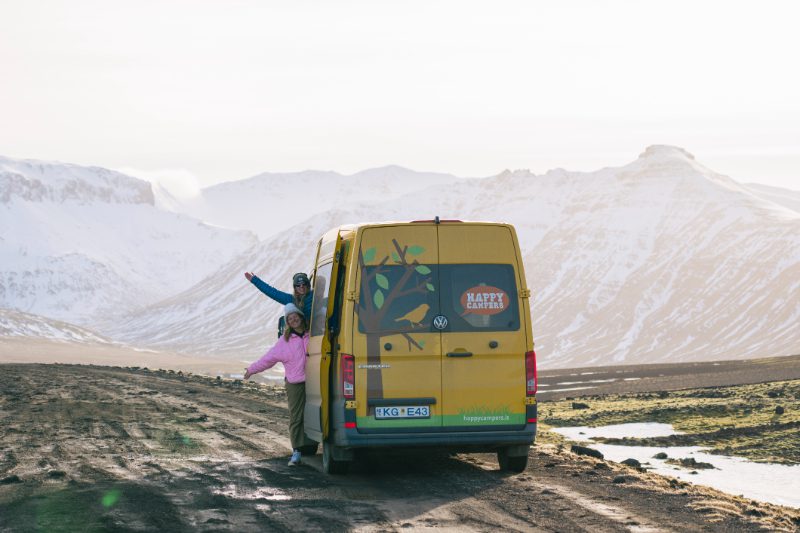
Winter in Iceland isn’t the time to cut corners on equipment. You’ll need proper tyres. Fortunately, all of our campers with studded winter tyres as standard. These grip like a mountain goat on espresso (now there’s an image), giving you control even on icy mountain passes and slick coastal stretches.
Not to sound like your mum or dad here, but always check your tyre pressure before heading out; the cold can drop it overnight and reduce traction. Opt for our winter kit as an extra an ice scraper, and a snow shovel amongst other items. These simple tools will become heroic when a storm blows through.
But rest assured that our team outfits every camper with emergency kits, though it never hurts to know where everything is before you need it. Icelandic conditions can change fast, and even the most careful drivers may find themselves temporarily stranded (don’t worry, you will never be Tom Hanks from Cast Away), so just in case keep some extra water with you (if nothing else, to splash your partner with out of sheer annoyance).
Layering is your best friend. The interior of your campervan is snugly heated, but step outside and you’ll find yourself in a world that feels several climate zones colder. Thermal base layers, a down or insulated jacket, a waterproof outer shell, and wool accessories will keep you warm when the wind bites (and it will bite). Good boots are vital: insulated, waterproof, and sturdy enough to handle slippery surfaces. Gloves, hats, and thick socks aren’t optional luxuries; they will keep you sane when you’re scraping frost off your windscreen in minus ten degrees (celcius).
Navigation also deserves a word. GPS and offline maps can at times be lifesavers in areas where mobile coverage can become sketchy (but the Ring Road is completely fine), though Happy Campers’ vans come with pre-installed navigation systems and reliable 4G Wi-Fi to keep you on course. Keep an eye on your route and always mark the nearest service station or emergency shelter before driving into remote areas. Iceland’s vastness means you can travel for long stretches without seeing another vehicle, so self-sufficiency is key (maybe a game of iSpy too?)
Finally, don’t underestimate the little comforts: a thermos of coffee, or even a pack of hot chocolate sachets can turn a cold roadside break into a small moment of joy. But most of all, don’t leave your funny bone at home, because sometimes even the wildest situations need a good giggle or two.
Weather, Wind and Whiteouts: Reading Iceland’s Forecasts
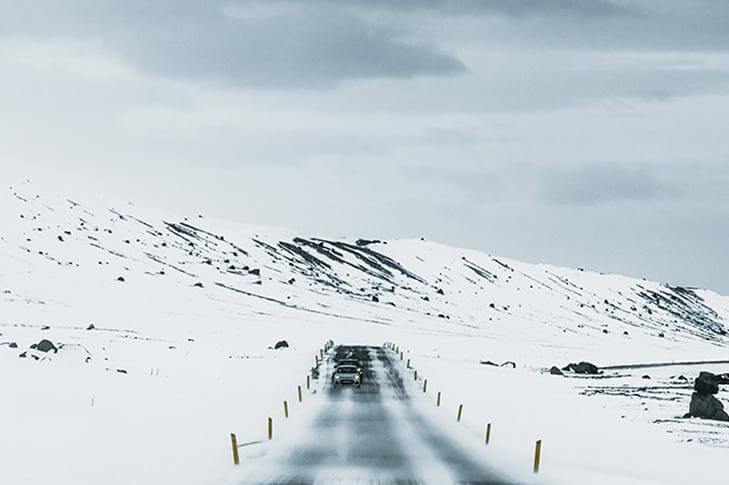
If you take one thing from this article, let it be this: check the weather (sing it out loud if you have to).
Iceland’s weather is a shapeshifter, capable of turning a calm morning into a beastly snowstorm before you’ve finished your latte. The Icelandic Met Office should become your most visited website. They issue detailed warnings, colour-coded by danger level. If you’re in a region with an active yellow, orange, or red weather warning, we advise waiting it out (Dennis Quad in the Day After Tomorrow style).
Understanding the forecasts takes a bit of practice. Each region of Iceland (south, west, north, east, and the Highlands) can have wildly different conditions on the same day. It’s not uncommon to have blue skies in Reykjavik while a blizzard rages around Vík.
The forecast maps will show wind speed in metres per second (20 m/s is roughly 45 mph, enough to make walking more of a struggle than this conversion) and precipitation in millimetres. Anything above 25 m/s should make you rethink your driving plans. You’ll also see “road alerts” for ice, drifting snow, or poor visibility. It is most wise to heed them religiously.
Wind is Iceland’s favourite pastime and its most underrated danger. It can reach speeds strong enough to, well, let’s not think about that (they can be crazy strong, particularly in the west). It’s good practice to always park facing the wind, especially on exposed coasts or at viewpoints. Hold your door firmly when exiting; a sudden gust can get the stress juices pumping a little too much for comfort. Also, avoid standing between any vehicles in high winds, and don’t underestimate how hard it is to walk in gale conditions. If it feels unsafe, it probably is (great advice for basically…everything in life).
Snowstorms, sleet, and whiteouts can roll in at frightening speed, reducing visibility to nothing. On roads like the south coast or mountain passes, that means you may not see the next reflective pole, let alone another car.
If that happens, pull over safely, keep your hazard lights on, and wait it out. Never stop in the middle of the road or try to “push through” a whiteout, as many rescue calls start that way (so try not to join these statistics).
You can also download the SafeTravel Iceland app, which sends alerts and updates straight to your phone. Combine that with road.is for live camera feeds of major roads and conditions, and you’ll have a near-real-time picture of what lies ahead. Iceland rewards patience, preparedness, and the ability to know when to call it a day (don’t be a hero, you hear me!)
Staying Safe (and Sane) Behind the Wheel
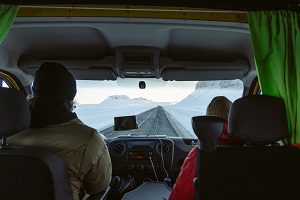
Driving safely here is mainly about keeping your cool when Iceland’s wild weather decides to test you. The roads can change character in minutes: from clear and dry to slick with black ice or buried under a sudden snow squall (particularly at higher terrains).
Keep both hands on the wheel, avoid sudden braking or sharp steering, and maintain a much greater following distance than you would at home (unless you live in an igloo), ideally three times the normal gap. When it’s icy, stopping distances increase dramatically, and even studded tyres can only do so much when you log the basic physics of grip with increases in speed. Use your gears rather than your brakes on descents, accelerate gently, and stay alert to subtle shifts in traction beneath your wheels.
If a storm hits, locals often pull into the nearest café, or petrol station to wait it out if caught by surprise. You can do the same, there’s no shame in sipping a hot chocolate while watching the storm playing curling with some traffic cones lazily left out. Icelandic driving wisdom is built on patience, not persistence.
Visibility can be just as treacherous as ice. Snow glare, fog, and long hours of darkness make headlights your best ally. Keep them on at all times (it’s also the law all-year round to do so), clean your windshield frequently, and remember that other drivers may not see you as clearly as you see them. If visibility drops too low, slow down, signal early, and pull over at a designated pull-off if necessary.
Animals occasionally wander onto roads (usually pretty comical). You get reindeer in the east, and basically sheep everywhere else. They’re slow, confused, and seem to time their road struts for the least pleasant moment, so take care. If you spot one ahead, brake gently and flash your lights to encourage it off the road. Never swerve suddenly; that’s how cars end up in ditches (out team of camper enthusiasts don’t like that too much).
And while we’re talking about common sense, never, ever stop in the middle of the road for photos. It’s dangerous, illegal, and incredibly frowned upon (not in the British way with a letter, there’s Facebook shaming and a fine). Iceland may look like a film set, but it’s not one, and every year a few tourists find that out the hard way. Use marked pull-offs or car parks for your shots, and you’ll return home with great pictures and your dignity intact (a solid combo).
The Beauty of Slowing Down: Winter Road Trip Itineraries
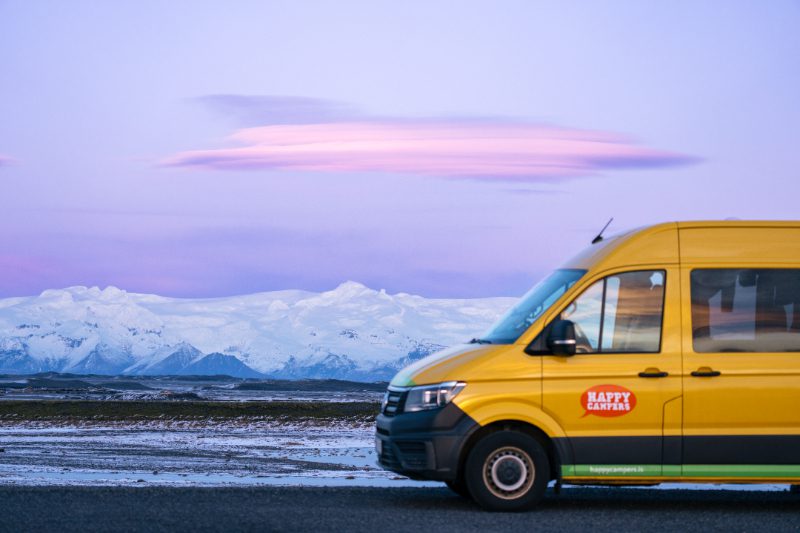
One of the greatest perks of campervan travel in Iceland’s winter is flexibility, which is true, glorious freedom on four wheels. You’re not tethered to hotel check-ins, restaurant reservations, or the rigid structure of group tours.
Instead, you can follow your instincts, the weather forecast (I acknowledge this sentence sounds a bit hypocritical), and perhaps a sudden hint of the Northern Lights glowing on the horizon.
With your home and heater on wheels, you can linger at that picturesque waterfall until the last light fades, or pull over to photograph the pink glow of dawn over a snowy mountain ridge, knowing that comfort is always within arm’s reach.
When planning your route, start simple. For a short yet iconic winter road trip, the Golden Circle remains unbeatable. Simply begin in Reykjavik and set your sights on Þingvellir National Park, Geysir, and Gullfoss.
Each site is easily reachable even when the snow settles, and the roads are well-maintained. Þingvellir offers the chance to walk between two continents under a frosting of snow, Geysir bursts through the ice at sporadic intervals, and Gullfoss is just a giant of giant waterfalls, so obviously you need to see it.
If you’ve got more time (and more caffeine stashed up), extend your adventure south along the Ring Road. This stretch to Vík is one of Iceland’s most stunning winter drives, where the contrast between white snow and black volcanic sands feels almost surreal (and yes, this area has been in a tonne of films).
Stop by Seljalandsfoss and Skógafoss, which are two waterfalls that’s edges freeze into shimmering sculptures when temperatures drop. Then carry on to Reynisfjara Black Sand Beach, where the Atlantic waves crash dramatically against basalt columns, before heading east toward Jökulsárlón Glacier Lagoon. Few experiences compare to waking up in your camper beside Vatnajökull National Park (Europe’s largest glacier), sipping morning coffee as blue icebergs drift silently past (unless you also spot some seals on the ice).
Travellers with a week or more might venture farther east to Höfn for steaming lobster soup and the eastfjords (the classic soup and rock combo), or north to Akureyri via the dramatic fjords (weather permitting).
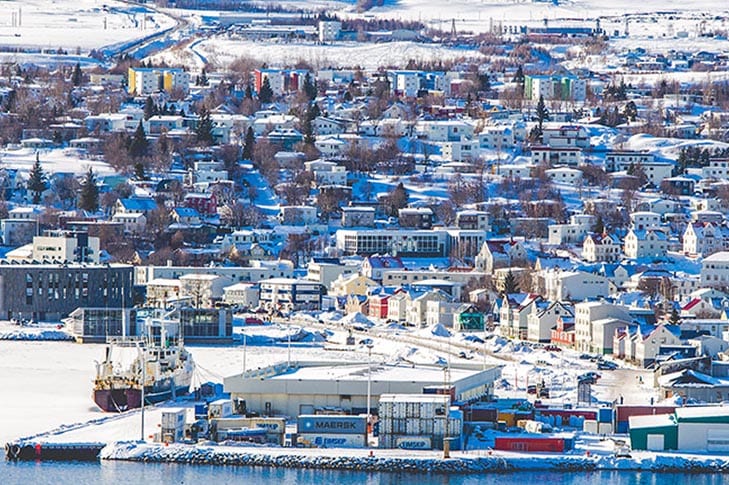
Each region offers a different flavour of winter Iceland, which is usually quieter, more rugged, and often more rewarding. Not to brag…but our campers are built for this kind of slow, exploratory travel, letting you change plans on a whim without losing comfort or warmth. They keep you as gripped to the road as much as you will be gripped to the sights (see what I did there?)
If luck (and clear skies) are on your side, you should also catch many renditions of the Northern Lights. They appear most often between 10pm and 2am when the skies are dark and the solar activity is strong.
Because you can park almost anywhere outside town limits (safely off the road in designated pull-offs or at a campsite, of course), your campervan gives you a private observatory. Pull up near a cool natural foreground like Kirkjufell mountain in Snæfellsnes, switch off the lights, and let the aurora dance across the windscreen while you stay warm inside, delivering proof that in Iceland, adventure and luxury can coexist beautifully (well, sort of).
When Not to Drive (and What to Do Instead)
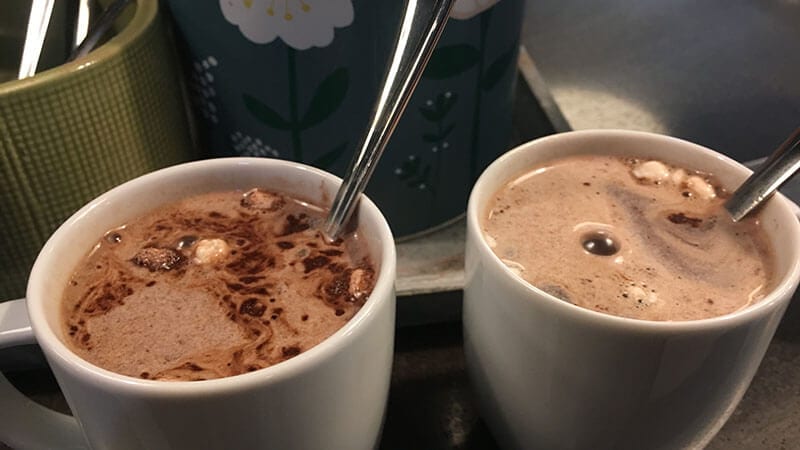
Sometimes, Iceland simply says “no.” And that’s fine. If roads are closed, the weather’s gone rogue, or the wind has decided it wants to slap you about a bit, there’s no point pushing it.
Icelandic storms are magnificent, but they don’t negotiate (with you or terrorists). When authorities close a road, it’s not because they’re being cautious, it’s because somewhere along that route, nature has quite literally taken over. Accepting that is part of the Icelandic travel mindset: adapt, don’t resist (or as they prefer to say, “Þetta reddast”, meaning “it will all work out”).
Use those days to explore Iceland’s slower, softer side. There’s an entire world of cosy adventure waiting indoors. Sink into one of the country’s geothermal pools like the Sky Lagoon (unless you’re under a vortex) and let the steam thaw both your limbs and your travel ambitions.
If the weather is ok, take a wander through Reykjavik’s compact but culture-packed streets, stopping for a cheeky Snúður at Brauð & Co. or sampling lamb soup and rye bread at a local café while the wind howls outside (very Icelandic).
If you fancy learning something between spoonfuls, then Perlan Museum offers interactive exhibits on glaciers and volcanoes (all safely behind glass last I checked). Or, if you’re parked somewhere rural, whack up the heating, brew some strong coffee, and watch the snow swirl from the comfort of your rolling cabin (from a safe spot, not a cliff edge).
Our campervans are designed for precisely these moments. They come equipped with efficient heating, cooking gear, and enough space to turn a day of bad weather into an oddly delightful retreat.
After all all our campers are simply tiny Nordic cabin on wheels, a place where you can read, nap, cook, or plan your next sunny patch of road (touch wood). Many travellers say these quiet pauses become the most memorable parts of their trip. And when the storm finally clears, you’ll be rested, (highly) caffeinated, and ready to roll again into a freshly frosted landscape that feels brand new and crisp (or continue the nap more peacefully).
Final Thoughts: Embrace the Madness, Respect the Ice
Driving in Iceland in winter isn’t for everyone. But for those who dare, it’s unforgettable. You’ll see landscapes few others have the pleasure of witnessing, such as glaciers glowing pink at sunrise, frozen cascades of waterfalls completely different to their old summer selfs, and black sand beaches lightly dusted in snow (like a Victoria Sponge cake…or a Charlie Sheen party).
The trick is to stay humble. Respect the conditions, drive smart, and embrace the chaos. Our campers give you everything you need to be well prepped: studded tyres, warmth, freedom, and a sense of adventure that fits neatly in the glove box (or you might pack that last part yourself).
Winter in Iceland is about going with the flow, even if that flow is occasionally frozen solid.
Back